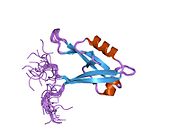PPP1R9A
Appearance
Neurabin-1 is a protein that in humans is encoded by the PPP1R9A gene.[5][6]
References
- ^ a b c GRCh38: Ensembl release 89: ENSG00000158528 – Ensembl, May 2017
- ^ a b c GRCm38: Ensembl release 89: ENSMUSG00000032827 – Ensembl, May 2017
- ^ "Human PubMed Reference:". National Center for Biotechnology Information, U.S. National Library of Medicine.
- ^ "Mouse PubMed Reference:". National Center for Biotechnology Information, U.S. National Library of Medicine.
- ^ Nagase T, Ishikawa K, Kikuno R, Hirosawa M, Nomura N, Ohara O (Jan 2000). "Prediction of the coding sequences of unidentified human genes. XV. The complete sequences of 100 new cDNA clones from brain which code for large proteins in vitro". DNA Res. 6 (5): 337–45. doi:10.1093/dnares/6.5.337. PMID 10574462.
- ^ "Entrez Gene: PPP1R9A protein phosphatase 1, regulatory (inhibitor) subunit 9A".
Further reading
- Maruyama K, Sugano S (1994). "Oligo-capping: a simple method to replace the cap structure of eukaryotic mRNAs with oligoribonucleotides". Gene. 138 (1–2): 171–4. doi:10.1016/0378-1119(94)90802-8. PMID 8125298.
- Nakanishi H, Obaishi H, Satoh A, et al. (1997). "Neurabin: A Novel Neural Tissue–specific Actin Filament–binding Protein Involved in Neurite Formation". J. Cell Biol. 139 (4): 951–61. doi:10.1083/jcb.139.4.951. PMC 2139968. PMID 9362513.
- Suzuki Y, Yoshitomo-Nakagawa K, Maruyama K, et al. (1997). "Construction and characterization of a full length-enriched and a 5'-end-enriched cDNA library". Gene. 200 (1–2): 149–56. doi:10.1016/S0378-1119(97)00411-3. PMID 9373149.
- McAvoy T, Allen PB, Obaishi H, et al. (1999). "Regulation of neurabin I interaction with protein phosphatase 1 by phosphorylation". Biochemistry. 38 (39): 12943–9. doi:10.1021/bi991227d. PMID 10504266.
- Stephens DJ, Banting G (1999). "Direct interaction of the trans-Golgi network membrane protein, TGN38, with the F-actin binding protein, neurabin". J. Biol. Chem. 274 (42): 30080–6. doi:10.1074/jbc.274.42.30080. PMID 10514494.
- Oliver CJ, Terry-Lorenzo RT, Elliott E, et al. (2002). "Targeting Protein Phosphatase 1 (PP1) to the Actin Cytoskeleton: the Neurabin I/PP1 Complex Regulates Cell Morphology". Mol. Cell. Biol. 22 (13): 4690–701. doi:10.1128/MCB.22.13.4690-4701.2002. PMC 133892. PMID 12052877.
- Strausberg RL, Feingold EA, Grouse LH, et al. (2003). "Generation and initial analysis of more than 15,000 full-length human and mouse cDNA sequences". Proc. Natl. Acad. Sci. U.S.A. 99 (26): 16899–903. doi:10.1073/pnas.242603899. PMC 139241. PMID 12477932.
- Scherer SW, Cheung J, MacDonald JR, et al. (2003). "Human Chromosome 7: DNA Sequence and Biology". Science. 300 (5620): 767–72. doi:10.1126/science.1083423. PMC 2882961. PMID 12690205.
- Hillier LW, Fulton RS, Fulton LA, et al. (2003). "The DNA sequence of human chromosome 7". Nature. 424 (6945): 157–64. doi:10.1038/nature01782. PMID 12853948.
- Ota T, Suzuki Y, Nishikawa T, et al. (2004). "Complete sequencing and characterization of 21,243 full-length human cDNAs". Nat. Genet. 36 (1): 40–5. doi:10.1038/ng1285. PMID 14702039.
- Kimura K, Wakamatsu A, Suzuki Y, et al. (2006). "Diversification of transcriptional modulation: Large-scale identification and characterization of putative alternative promoters of human genes". Genome Res. 16 (1): 55–65. doi:10.1101/gr.4039406. PMC 1356129. PMID 16344560.









